
Solutions for Invasive Species Continue to Flow in the Adirondacks
Tuesday, March 8, 2016
By Kevin Chlad - Director of Government Relations
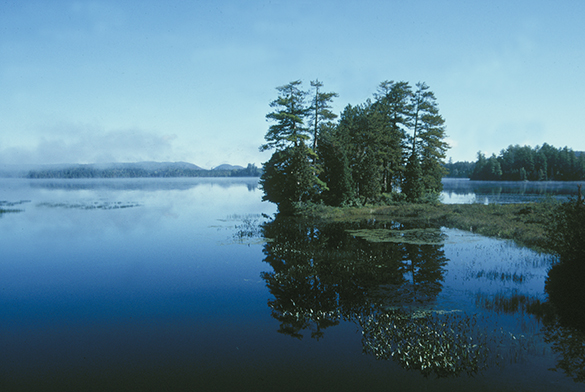 As I stood there holding the canoe steady, my wife Michelle pulled our bags out of the boat and onto the shore, while I stole one last glimpse across Little Clear Pond. The sky was overcast and the water was calm. The flap of a loon near the opposite shore seemed to be a farewell wave. We were eager to grab a hearty breakfast in Saranac Lake, as we had just paddled our way from Raquette Lake over the course of five days. We had been blessed with nearly perfect weather, real solitude and best of all… clean water.
As I stood there holding the canoe steady, my wife Michelle pulled our bags out of the boat and onto the shore, while I stole one last glimpse across Little Clear Pond. The sky was overcast and the water was calm. The flap of a loon near the opposite shore seemed to be a farewell wave. We were eager to grab a hearty breakfast in Saranac Lake, as we had just paddled our way from Raquette Lake over the course of five days. We had been blessed with nearly perfect weather, real solitude and best of all… clean water.
There has always been something special about the Adirondacks that people have sought to identify and make tangible...the “spirt” of this special place. I would argue that the Park’s magic is due in part to many different things, but the life blood of the Adirondacks is, without a doubt, clean water.
Unfortunately, clean water in the Adirondack Park currently faces a very serious threat that will challenge its very fabric: invasive species.
I had come to realize this as Michelle and I prepared our boat for launch into Raquette Lake just five days earlier. We met an invasive species prevention steward who kindly informed us about the threats posed by these insidious creatures and explained a few simple ways we could avoid contributing to their spread.
I pondered this topic as we pushed off from shore. I thought about the number of lakes, ponds and streams in the Adirondacks alone, and the popularity of boating in the Park, and its importance to communities in the summer months. I thought about the species that would suffer from disrupted food chains and the potential Park-wide impacts to property values. Soon this thought became too much to process in a time intended for recreation 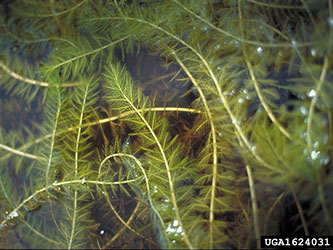
Eurasion Water Milfoil
photo courtesy of APPIPand solitude.
Thankfully, my time spent with the Adirondack Council has shown me that there is great reason to be optimistic. Over the last couple of years, a large, coordinated effort has emerged to prevent the spread of invasive species into the Adirondack Park. The focus is on funding, policy and making sure the Department of Environmental Conservation and the Park’s coalition of stakeholders are able to meet their full potential in protecting clean water.
Currently, the New York State Legislature is debating what will go into the final budget. If all goes well, efforts to prevent the spread of invasive species in the Adirondacks will be adequately funded. The Governor has proposed to increase the state’s Environmental Protection Fund (EPF) to $300 million, which includes $10 million for fighting invasive species, which the Council supports. However, it remains to be seen what the legislature will do.
The Council also supports the Governor’s proposed increase of the eradication grants subcategory in the EPF, growing this dedicated funding from $1 million to $2 million. Invasive species funding backs important education and spread prevention efforts such as the Adirondack Invasive Species Prevention Strategy, which focuses on stewardship, data collection, education, boat inspections and when necessary, decontamination of boats and trailers. This program’s proposed expansion will give Adirondack communities, lake associations and partners, such as the Adirondack Park Invasive Species Prevention Program (APIPP), a fighting chance against the potentially devastating threat of aquatic invaders.
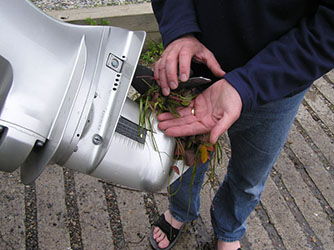
Eurasion milfoil tangled in motor prop
photo courtesy of APIPP
Ultimately, it is our hope to see more robust funding for lake associations and communities to fight aquatic invasives, as they often volunteer their time and self-fund their efforts to keep invasive species from entering and/or spreading in their waters. Finally, we support the groundbreaking efforts on Lake George to protect the lake, the Adirondack Park and the rest of the state through an invasive species spread prevention/education effort, which is proposed to be funded again at $450,000.
Another important and timely funding matter that the Council hopes will be addressed is a long-needed boat and dock fee adjustment for the Lake George Park Commission (the Commission). This is needed in order for it to remain solvent and continue its efforts to maintain clean water and quality recreation on Lake George.
The Commission is tasked with expanding duties to protect the lake, which include invasive species management, stormwater control and marine patrolling for public safety. And, it has had only one fee increase in its 28-year history. At the current income/expenditure levels, the reserves for the Commission will be depleted within three years. Then it will have to cut staffing and programs. It is essential that the Commission remain fiscally 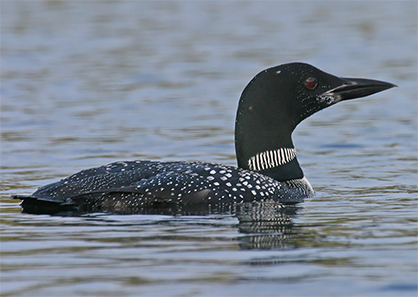 strong and able to fulfil its mandate to protect the water quality of Lake George.
strong and able to fulfil its mandate to protect the water quality of Lake George.
So much is happening on Lake George, on the other 2,800 water bodies in the Adirondack Park and across the state to prevent the spread of invasive species. Without proper funding, all of the policies and programs that people have worked hard to put in place will be for naught. If we lose this battle, I worry that I might return to Little Clear Pond one day, absent the greeting of the loon with its flapping wing. It just won’t be the same.
|
Would you like to comment on what you've read or viewed? We'd love to hear from you. Please click to send us a message.
|
|||

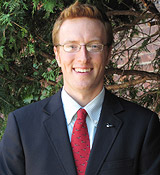 Kevin joined the Adirondack Council staff in 2011.
Kevin joined the Adirondack Council staff in 2011.


